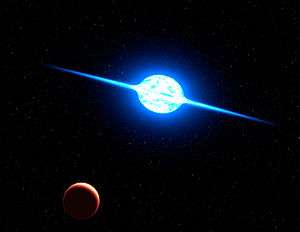VFTS 102
 Artistic depiction of VFTS 102 | |
| Observation data Epoch J2000 Equinox J2000 | |
|---|---|
| Constellation | Dorado |
| Right ascension | 05h 37m 39.248s[1] |
| Declination | −69° 09′ 51.04″[1] |
| Apparent magnitude (V) | 15.806[2] |
| Characteristics | |
| Evolutionary stage | Main sequence |
| Spectral type | O9:Vnnne[3] |
| U−B color index | −0.879[2] |
| B−V color index | +0.293[2] |
| Astrometry | |
| Radial velocity (Rv) | 228[3] km/s |
| Proper motion (μ) | RA: 7.3[1] mas/yr Dec.: 2.1[1] mas/yr |
| Distance | 164,000 ly (50,000 pc) |
| Details[3] | |
| Mass | ~ 25 M☉ |
| Luminosity | 100,000 L☉ |
| Surface gravity (log g) | 3.6 ± 0.5 cgs |
| Temperature | 36,000 ± 5000 K |
| Rotational velocity (v sin i) | 600±100 km/s |
| Other designations | |
2MASS J05373924-6909510 | |
| Database references | |
| SIMBAD | data |

VFTS 102 is a star located in the Tarantula nebula, a star forming region in the Large Magellanic Cloud, a satellite galaxy of the Milky Way.
The peculiarity of this star is its projected equatorial velocity of ~600 km/s (about 2.000.000 km/h), making it the fastest rotating massive star known.[4] The resulting centrifugal force tends to flatten the star; material can be lost in the loosely bound equatorial regions, allowing for the formation of a disk. The spectroscopic observations seem to confirm this, and the star is classified as Oe, possibly due to emission from such an equatorial disk of gas.
This star was observed by the VLT Flames Tarantula Survey collaboration using the VLT, Very Large Telescope in Chile. One member of this team is Matteo Cantiello, an Italian astrophysicist who emigrated to the United States and is currently working at the Kavli Institute for Theoretical Physics at University of California Santa Barbara. In 2007, together with a few collaborators, he predicted the existence of massive stars with properties very similar to VFTS 102. In its theoretical model, the extreme rotational speed is caused by the transfer of material from a companion star in a binary system. After this "cosmic dance", the donor star is predicted to explode as a supernova. The spun-up companion instead is likely to be launched out of the orbit and move away from its stellar neighbors at high speed. Such a star is called a runaway. VFTS 102 fits this theoretical model very well, being found to be a rapidly rotating runaway star and lying close to a pulsar and a supernova remnant. Other scenarios, like a dynamical ejection from the core of the star cluster R136, are also possible.[5]
References
- 1 2 3 4 Cutri, R. M.; Skrutskie, M. F.; Van Dyk, S.; Beichman, C. A.; Carpenter, J. M.; Chester, T.; Cambresy, L.; Evans, T.; Fowler, J.; Gizis, J.; Howard, E.; Huchra, J.; Jarrett, T.; Kopan, E. L.; Kirkpatrick, J. D.; Light, R. M.; Marsh, K. A.; McCallon, H.; Schneider, S.; Stiening, R.; Sykes, M.; Weinberg, M.; Wheaton, W. A.; Wheelock, S.; Zacarias, N. (2003). "VizieR Online Data Catalog: 2MASS All-Sky Catalog of Point Sources (Cutri+ 2003)". VizieR On-line Data Catalog: II/246. Originally published in: 2003yCat.2246....0C. 2246. Bibcode:2003yCat.2246....0C.
- 1 2 3 Bonanos, A. Z.; Massa, D. L.; Sewilo, M.; Lennon, D. J.; Panagia, N.; Smith, L. J.; Meixner, M.; Babler, B. L.; Bracker, S.; Meade, M. R.; Gordon, K. D.; Hora, J. L.; Indebetouw, R.; Whitney, B. A. (2009). "Spitzer SAGE Infrared Photometry of Massive Stars in the Large Magellanic Cloud". The Astronomical Journal. 138 (4): 1003. arXiv:0905.1328
 . Bibcode:2009AJ....138.1003B. doi:10.1088/0004-6256/138/4/1003.
. Bibcode:2009AJ....138.1003B. doi:10.1088/0004-6256/138/4/1003. - 1 2 3 Dufton, P. L.; Dunstall, P. R.; Evans, C. J.; Brott, I.; Cantiello, M.; De Koter, A.; De Mink, S. E.; Fraser, M.; Hénault-Brunet, V.; Howarth, I. D.; Langer, N.; Lennon, D. J.; Markova, N.; Sana, H.; Taylor, W. D. (2011). "The VLT-FLAMES Tarantula Survey: The Fastest Rotating O-type Star and Shortest Period LMC Pulsar—Remnants of a Supernova Disrupted Binary?". The Astrophysical Journal Letters. 743: L22. arXiv:1111.0157
 . Bibcode:2011ApJ...743L..22D. doi:10.1088/2041-8205/743/1/L22.
. Bibcode:2011ApJ...743L..22D. doi:10.1088/2041-8205/743/1/L22. - ↑ Jiang, Dengkai; Han, Zhanwen; Yang, Liheng; Li, Lifang (2013). "The binary merger channel for the progenitor of the fastest rotating O-type star VFTS 102". Monthly Notices of the Royal Astronomical Society. 428 (2): 1218. arXiv:1302.6296
 . Bibcode:2013MNRAS.428.1218J. doi:10.1093/mnras/sts105.
. Bibcode:2013MNRAS.428.1218J. doi:10.1093/mnras/sts105. - ↑ Cantiello, M.; Yoon, S.-C.; Langer, N.; Livio, M. (2007). "Binary star progenitors of long gamma-ray bursts". Astronomy and Astrophysics. 465 (2): L29. arXiv:astro-ph/0702540
 . Bibcode:2007A&A...465L..29C. doi:10.1051/0004-6361:20077115.
. Bibcode:2007A&A...465L..29C. doi:10.1051/0004-6361:20077115.
External links
- ESO Press Release
- STScI Press Release
- News on "Corriere della Sera"
- News on "Il Tirreno"
- Press Release at University of California Santa Barbara
- VFTS102 on DailyMail
- VLT Flames Tarantuala Survey Homepage
- Matteo Cantiello HomePage